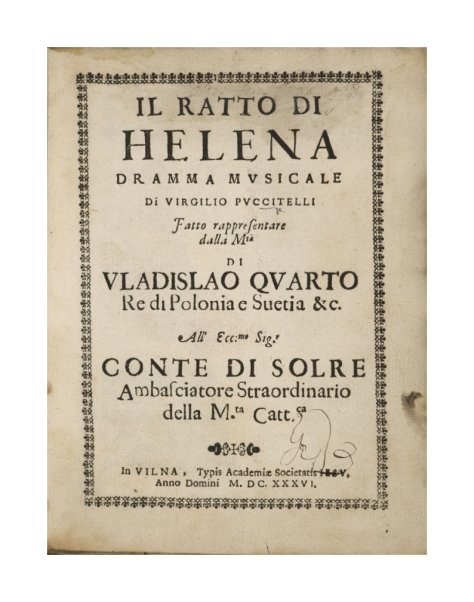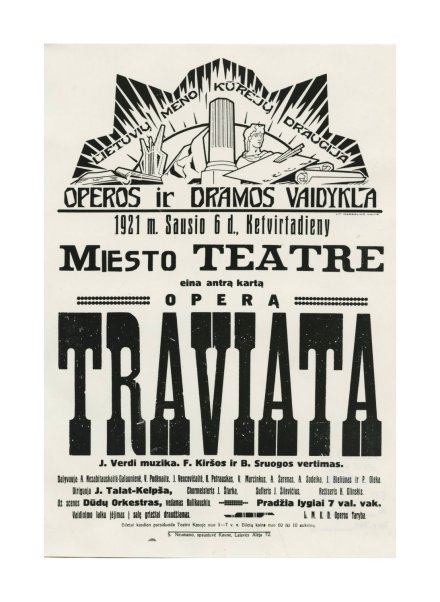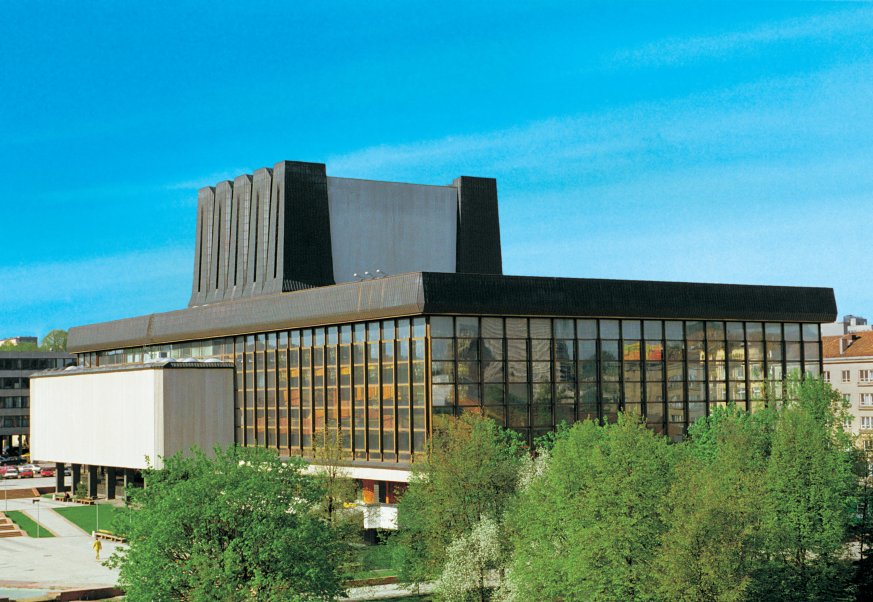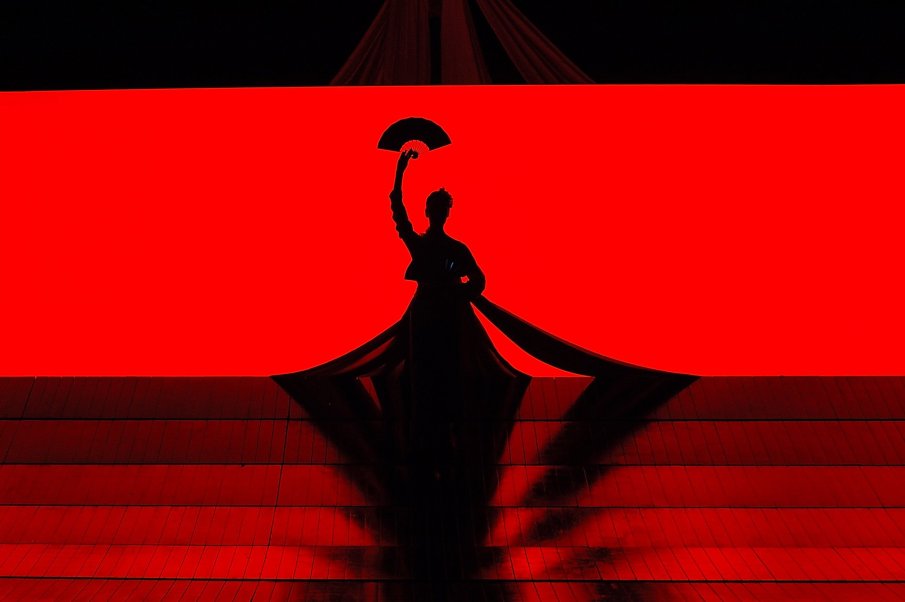
4 September 1636. The first opera performance in Lithuania took place at the theatre of the Palace of the Grand Dukes of Lithuania in the Lower Castle. Vilnius became one of the first European capitals to get acquainted with the new genre of baroque art.
18th Century. Opera and ballet was established in Lithuania in the theatres of the palaces of noblemen, high-ranking state officials Radvilas, Oginskies, and Sapiegas.
1785. Public city theatres have started operating in Vilnius and Klaipėda. The history of public theatre in Vilnius was initiated by the famous Polish theatre figure Wojciech Bogusławski. Later, until 1864, theatres welcomed performances by various Polish and German entrepreneurs, then after the 1863–1864 uprising – Russian, quite often Italian opera companies. In 1844, after the theatre was installed at the Perkūnas House in Kaunas, and in 1892, after the construction of the theatre palace, Vilnius’ troupes toured there as well.
6 November 1906. The first Lithuanian opera “Birutė” by playwright Gabrielius Landsbergis-Žemkalnis and composer Mikas Petrauskas, was shown in the current Philharmonic Hall in Vilnius.

1920. The Society of Lithuanian Creators of Art has established the “Operos vaidykla”, the current National Opera and Ballet Theatre, in the temporary capital of Kaunas, which performed its first premiere – G. Verdi's "Traviata" – on 31 December. This day is considered to be the birthday of our theater.
4 December 1925. The ballet company, which had previously performed in operas or concerts, performed its first solo performance, Leo Delibes' “Coppelia”.
Starting with 1926, approximately every other opera (and sometimes ballet) performance was broadcasted by the Kaunas radio.
1935. The ballet travelled abroad: in January it performed 10 performances in Monte Carlo, in February – March it presented 32 performances at the London (Alhambra Theatre). The repertoire included "Giselle", "Coppelia", "Swan Lake", "Raimonda" (Lithuanian Theatre was the first company to show one of M. Petipa's last choreographic masterpieces to the West), as well as "Matchmaking" and several other one-act ballets. The soloists of the theatre’s opera company visited the stages of Riga, Tallinn, Stockholm, Paris, Prague, Rome, Milan; in 1936 a a group of soloists also sang at the Colon Theatre in Buenos Aires.
Until 1940 during the Soviet occupation, the repertoire included works by Lithuanian and foreign composers: the theatre presented 61 operas by 41 composer, and the ballet company prepared premieres of 36 ballets by 29 composers. Among them were the most important romantic ballets and modern works, in 1933 the first Lithuanian ballets also appeared. The theatre life was disrupted due to the fate of its members in 1940 – they were burdened by Soviet occupation, war, Nazi occupation. However, those events did not fundamentally change the activities of the theatre.
The artistic forces of the operatic art had grown so much that the Kaunas Operetta (currently Musical Theater) was established in 1940. In 1942 Vilnius also presented its Opera House (before the 2nd Soviet occupation it prepared premieres of 6 operas and one ballet).
1944. At the beginning of the Second Soviet Occupation, theatre, just as the rest of the culture, suffered a serious tragedy: almost 30 opera soloists, almost half of the ballet company, excellent conductors, chorus masters, stage designers and composers left for the West. Gathered in Detmold, in 1947 they produced and presented 20 performances of “Il barbiere di Siviglia”, in 1948 in Augsburg – "Coppellia" (performed almost 14 times), also gave very frequent concerts. Afterwards, many artists escaped to the United States, where in 1957 a unique phenomenon in the world – the Lithuanian Opera in Chicago – came to be. Meanwhile, the theatres of Vilnius and Šiauliai were abolished in Lithuania, the connections with European theatres and the centres of vocal pedagogy were cut off, and Lithuanian culture seemed to be divided into two parts - here and abroad.
1948. Opera and Ballet Theatre was moved from Kaunas to Vilnius, into an existing theatre building on J. Basanavičiaus street.
Soviet control halted performances produced in modern style, even productions of operas and ballets of the world-repertoire that have become classics of the theatre stage. As the "socialist creation" was rather difficult and slow, its lack was compensated by the works of Russian composers (P. Tchaikovsky, M. Mussorgsky, N. Rimsky-Korsakov, etc.), which were often called "realistic" and “forward-thinking”. Over time, the balance of the repertoire was restored. As political oppression changed and eased, so did cultural politics. The theatre remained an important place for the hearth of national artistic culture to foster true spiritual values, where there was never a shortage of talented and dedicated people.
In 1974 the theatre moved to the new building on A. Vienuolio str. (architect Nijolė Bučiūtė). The possibilities of some of the most modern stage techniques of that time expanded the artistic possibilities of staging various works. The new theatre became one of the most famous stages in the Soviet Union.
In 1987 changes began in the life of the theater, as well as in political life. Relations with Lithuanian musicians abroad were revived. In January 1988, the entire theatre crossed the border of the still-surviving USSR for the first time, with ballet and opera companies performing at the Teatr Wielki in Warsaw. The restored connections with the world are one of the most significant features of today's theatre. The opera and ballet companies go on tours almost every year, with world-renowned guests artists at the theatre.

On 1 July 1998 the theatre was declared a national institution and officially became the Lithuanian National Opera and Ballet Theatre.
2001. LNOBT invited theatregoers to Trakai. From then on every year until 2011 performances in the open-air courtyard of the castle gathered large crowds of spectators.
2003. The theatre joined prestigious international art organizations: ISPA (International Performing Arts Society) and the association “Opera Europa”.
In September 2005 LNOBT published the first issue of a comprehensive, illustrated magazine “Bravissimo”, covering issues of opera and ballet both in Lithuania and in the world.

In 2006 LNOBT presented its first co-production with two famous theatres: G. Puccini's "Madama Butterfly" directed by Anthony Minghella, produced together with the English National Opera and the Metropolitan Opera in New York. At the present, the theatre has already prepared 12 co-productions, and the LNOBT has been assessed as an equal partner to the most famous opera houses in the world.
2012. After the initiative of K. Pastor, the artistic director of LNOBT’s ballet company, the annual project “Creative Impulse” was introduced, which allowed dancers to reveal their choreographic talent. The project has already raised several new choreographers.
2019. The ballet “Der Prozess” created by choreographer Martynas Rimeikis was broadcasted on the Mezzo TV channel – it was the first Lithuanian production to be streamed on this famous platform.